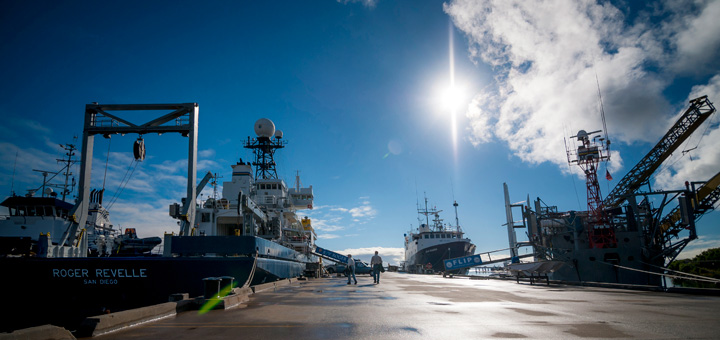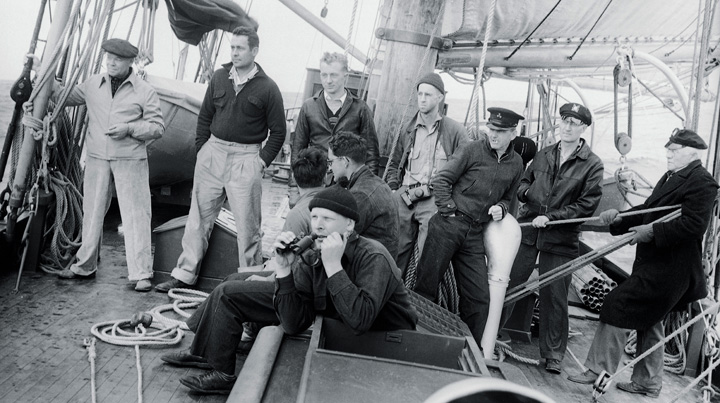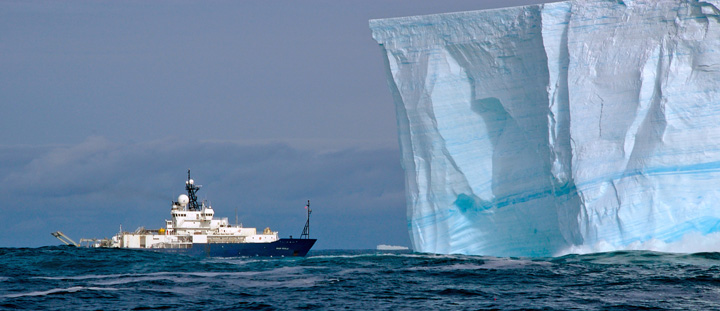
By:
- Rob Monroe
Published Date
By:
- Rob Monroe
Share This:
A Fleet for All
Scripps’ armada of research vessels provides platform for addressing critical scientific challenges facing planet

Photo by Erik Jepsen/UC San Diego Publications
Christina Frieder is a graduate student at Scripps Institution of Oceanography at UC San Diego who studies the effects of acidic and low-oxygen seawater on marine life.
But when she started at Scripps, she hadn’t considered the idea of actually helming a research vessel as chief scientist as part of her studies. Maybe something like that would happen later in her career, she figured. It took the influence of older students to spark the idea that learning how to lead a field research mission is something a student can do. Five years into her studies, she sure enough found herself telling the captain of the 279-foot Scripps research vessel Melville where to guide the vessel during the 2012 San Diego Coastal Expedition. There were four major experiments carried out during a two-part cruise, and she was in charge of coordinating all of them. No biggie.
“It’s just part of the culture here at Scripps,” she said.
Of all the things that make UC San Diego a rare place, it’s the operation of a fleet of four ships and one absolutely unique research platform that tops the list. Of all the members of the United States academic research fleet–which includes the University of Washington, Woods Hole Oceanographic Institution in Massachusetts and other universities—Scripps has the largest fleet and, by luck of geography, affords the greatest opportunity for researchers to gain access to a wide range of ocean environments.
"Scripps has a century-long history of seagoing excellence that is vital to the well-being of our planet and its pressing environmental challenges,” said UC San Diego Chancellor Pradeep K. Khosla. “Our high-tech fleet offers unparalleled opportunities for global ocean exploration, and we appreciate the confidence the U.S. Navy has in UC San Diego with stewardship of its newest, state-of-the-art vessel."
Scripps was four years old when it acquired its first research vessel, Alexander Agassiz, in 1907. It is believed to be the first ship in the United States built by a private company for the specific purpose of oceanographic research. The “fleet” for many of Scripps’s early decades would include borrowed vessels such as the yacht Loma owned by Scripps’s namesake and benefactor E.W. Scripps.
Thirty years after Agassiz was acquired, Scripps would pay homage to its patron by naming its newest research vessel E.W. Scripps. That vessel would help Scripps strike one of the most important enduring relationships in its history when the U.S. Navy chartered it for research during World War II. To this day, the Navy is both the fleet’s main benefactor and one of its biggest clients. It regularly sponsors research cruises through the Office of Naval Research. The Navy owns two Scripps vessels, R/V Roger Revelle, R/V Melville and the famous research platform known as FLIP, which fills partially with water as it moves into a vertical position at sea, creating an extremely stable platform for scientists who need to diminish wave movements when doing research.

Roger Revelle, second from left, and crew aboard E.W. Scripps during a 1939 cruise to the Gulf of California
The Navy is also funding the construction of the next Scripps ship, R/V Sally Ride, named for the late pioneering astronaut and UC San Diego physics professor. The new vessel will be in a category known as “Ocean Class” and come outfitted with advanced hull-mounted seafloor imaging equipment and Doppler current profilers. R/V Sally Ride will continue the relationship between Scripps and the Navy for the next 30 to 40 years, said Scripps Associate Director Bruce Appelgate.
“This is a new kind of research vessel, designed for capability and efficiency following the Scripps philosophy of operating general-purpose, shared-use oceanographic ships” said Appelgate, who oversees ship operations and marine technical support at Scripps. “Scripps has a strong record of conducting cutting-edge research on oceanographic expeditions around the world, and this ship represents an important next step in extending our ability to investigate issues that are fundamentally important to society.”
Ocean Class vessels are intended to be reliable, cost effective and flexible ships that have many of the capabilities of larger and more expensive Global Class vessels. The new ship will support interdisciplinary research, educational missions and engineering operations, with superior over-the-side equipment handling, station keeping and scientific system performance relative to previous research vessels of similar size.
"Our Navy and Marine Corps depend on detailed prediction of the ocean environment," said Chief of Naval Research Rear Adm. Matthew Klunder when the naming of the vessel was announced. "The new knowledge provided by our basic and applied research is critical for improvements to prediction systems. The research vessel Sally Ride will enable that research and represents the continuation of a long and fruitful partnership among the Navy, Scripps Institution of Oceanography, and the larger ocean science community."
It was with a pair of donated Navy vessels—a converted tug and minesweeper named Horizon and Crest, respectively—and a purse seiner bought with Navy funds called Paolina-T, that Scripps would help launch one of the longest-running ecological studies in history. The California Cooperative Oceanic Fisheries Investigations (CalCOFI) program was established in 1949 to seek fundamental understanding of the collapse of the California sardine fishery. The cruises, undertaken quarterly for most of CalCOFI’s history, continue today, building on a vast repository of data and tackling ever-more sophisticated issues in biological oceanography.
The Scripps fleet acquired a global reach after the war and the campus reaped the benefits of the new range of its ships. Scripps today houses the Scripps Oceanographic Collections, the largest and most comprehensive university-based oceanographic collection in the world, with millions of biological specimens and geological samples gathered from the world’s oceans over the past 100 years. In a 2005 interview, famed Scripps ichthyologist Richard Rosenblatt noted that it was standard practice over the decades for scientists from all fields who used Scripps vessels to bring back biological specimens, “kind of like tithing.”

R/V Roger Revelle cruises past an iceberg in the Antarctic. Photo by Paul Mauricio
The postwar years also saw the bond between Scripps and the Navy grow especially close as the Cold War created new needs for the military to understand a wide range of ocean properties—from circulation to the propagation of sound through water—that could come into play if warfare again came to the oceans. At Scripps, the main exponents of what would come to be known as the institution’s golden era of exploration, had personal Navy ties. Director Roger Revelle had joined the Navy’s Bureau of Ships during the war and oceanographer Walter Munk had guided amphibious assaults on enemy positions with his improvements on surf and swell forecasts. They and other Scripps researchers would take part in iconic expeditions to the Pacific Ocean such as Operation Crossroads and Capricorn, both of which included studies of the effects of atomic blasts at sea. Other cruises such as 1950’s Midpac were devoted to basic research on still largely unexplored expanses of the Pacific Ocean. From such expeditions would come the seeds of plate tectonic theory, identification of the deepest places on Earth’s surface and discoveries of life at hydrothermal vents.
During Frieder’s expedition, student researchers discovered a methane seep only a few miles off the San Diego coast—a first for this region. They had been guided by a bit of luck, finding mud samples consistent with a seep formation within a vast field of seafloor. The find now means another type of ocean terrain is within easy distance of San Diego. The research vessels of Scripps Institution of Oceanography, UC San Diego, are docked at the Scripps Nimitz Marine Facility on San Diego Bay in Point Loma. It takes only a few hours of cruising from there before Scripps vessels encounter very deep ocean, which makes the fleet well-situated for study of deep ocean environments and testing of instruments that must function under extreme pressures. East Coast oceanographic institutions must contend with a continental shelf that necessitates a day or more of travel to reach deep water. Most other academic fleets on either coast need to contend with weather that makes ocean research prohibitively difficult for several months every year.
To make it even easier for Scripps students to get their sea legs, the University of California provides rare funding to give them the opportunity that Frieder was afforded. The UC Ship Funds Program makes merit-based awards for ship time aboard research vessels operated by Scripps Institution of Oceanography and enables students and early-career scientists to conduct research and instruction at sea.
It was this pool of money that propelled one of the most prominent Scripps research expeditions of the past decade. UC Ship Funds supported the Scripps Environmental Accumulation of Plastic Expedition (SEAPLEX). From August 2 to 21, 2009, a group of doctoral students and research volunteers from Scripps Oceanography embarked on an expedition aboard the Scripps research vessel New Horizon. Their goal was to explore the problem of plastic in the North Pacific Gyre, one of the largest ecosystems on Earth, impacted by a deluge of accumulated plastic trash and, thus, dubbed the "Great Pacific Ocean Garbage Patch." SEAPLEX focused on a suite of critical scientific questions and continues to provide valuable scientific results, assessing the potential damage to marine life and alterations of the biological ocean environment.
Though modern research vessels still function in much the same way as they always have, other technologies have given scientists a new way to explore the oceans. Free-floating drifters, tethered buoys, and programmable gliders equipped with the latest in computer technology have provided blanket coverage of the oceans in a way that has never before been possible, greatly extending our ability to observe the oceans.
But as Scripps oceanographers know, shipboard seagoing research such as Frieder and her cohorts are learning will remain a vitally important aspect of Earth science. The most advanced remotely operated vehicles still need joystick-wielding operators to control them and deck crews to bring them back to safety; no robotic instruments yet exist that can collect water samples and other fundamental pieces of information from various ocean depths without assistance from people.
Frieder said her seagoing science experience will color how she approaches research for the rest of her career, placing forever in her mind the notion that one available way to observe the ocean is to go to it, get your feet wet and seafloor mud squished between your fingers. Now she has done it, and it has changed her.
“Being in the field gives you a unique perspective,” she said. “It influences how you think about the ocean.”
Share This:
You May Also Like
Stay in the Know
Keep up with all the latest from UC San Diego. Subscribe to the newsletter today.


